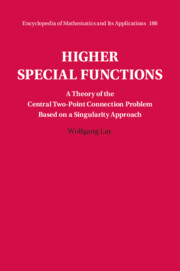 Higher Special Functions
Higher Special Functions Published online by Cambridge University Press: 16 May 2024
We now present examples of higher special functions. Since not all details are contained in the theoretical discussions of the field, it is these examples that mostly contribute to enable the reader to treat self-reliantly his or her concrete problem. Starting from the question of whether nature is linear or non-linear, the answer is not unambiguous. For weather phenomena, the underlying dynamics is undoubtedly non-linear. However, in the world of atoms and elementary particles, the processes become fundamentally linear. Mathematically, this is expressed by the fact that the underlying differential equation (the so-called Schrödinger equation) becomes linear in nature as soon as atomic processes are described. Hence, a substantial part of the examples here are devoted to solving boundary eigenvalue problems of the Schrödinger equation, the fundamental differential equation in the description of microscopic nature (quantum theory). The aim is autonomy to create new special functions by applying the methods developed. There may well be as yet unseen aspects, a variety of hitherto unknown special functions or even mathematically relevant new discoveries in the field.
To save this book to your Kindle, first ensure [email protected] is added to your Approved Personal Document E-mail List under your Personal Document Settings on the Manage Your Content and Devices page of your Amazon account. Then enter the ‘name’ part of your Kindle email address below. Find out more about saving to your Kindle.
Note you can select to save to either the @free.kindle.com or @kindle.com variations. ‘@free.kindle.com’ emails are free but can only be saved to your device when it is connected to wi-fi. ‘@kindle.com’ emails can be delivered even when you are not connected to wi-fi, but note that service fees apply.
Find out more about the Kindle Personal Document Service.
To save content items to your account, please confirm that you agree to abide by our usage policies. If this is the first time you use this feature, you will be asked to authorise Cambridge Core to connect with your account. Find out more about saving content to Dropbox.
To save content items to your account, please confirm that you agree to abide by our usage policies. If this is the first time you use this feature, you will be asked to authorise Cambridge Core to connect with your account. Find out more about saving content to Google Drive.